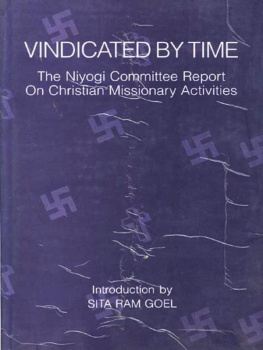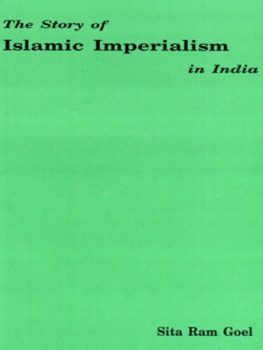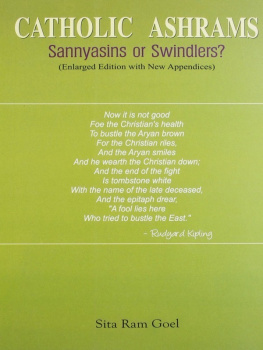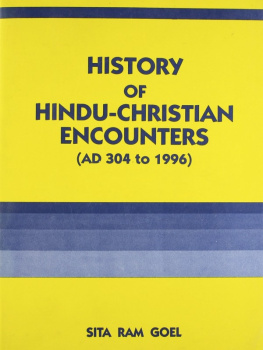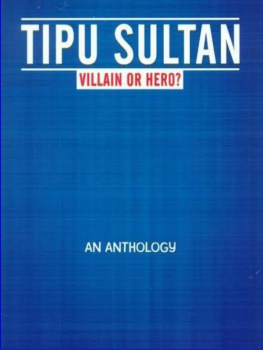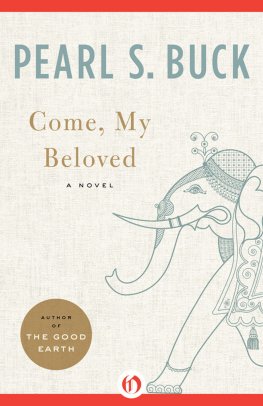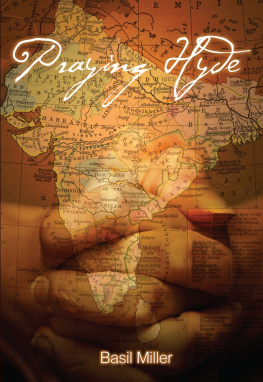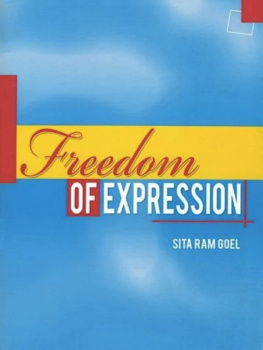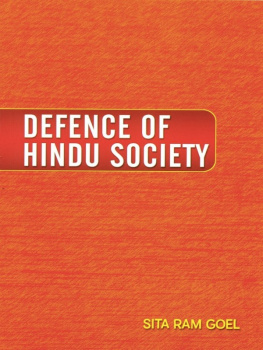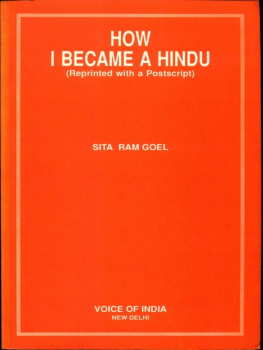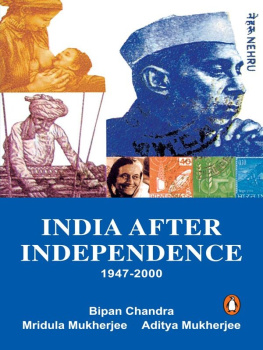PREFACE
Note: Install Devnagari Font to Read this eBook
It was the summer of 1982. VOICE OF INDIA had hardly started its programme of publications. One fine morning an aged and visibly ailing sannyasi dropped in at my office in New Delhi. He had travelled all the way from some place (I forget the name) in Andhra Pradesh. Someone had given him a copy of my booklet, Hindu Society Under Siege, and having read the chapter, Residue of Christianism, he had concluded that I was the guy he had been looking for. He introduced himself as Baba Madhavdas and placed on my table printed copies of a summary of the Niyogi Committee Report in English and Hindi, published by him. Before I could ask him to take a seat, he shot a question at me, You must have read the full Report? What do you think of it?
I felt small and confessed that although I had seen the full Report soon after it was published; I had not read it even cursorily. His face fell. I had disappointed him. He brightened only when I told him the story of how I had missed reading the full Report till that time, and promised to read it as soon as I could lay my hands on it from a Government shop or some library. He told me that it was no more available in the Government shops because Christian missionaries had bought all available copies and destroyed them. Even in libraries, it was rarely available because the same missionaries had seen to it that copies were removed, or borrowed and not returned.
When the Report was published by the Government of Madhya Pradesh in 1956, I happened to be in the district town of Shahdol in Vindhya Pradesh (then a separate State, now merged in Madhya Pradesh) for filing my nomination papers from that Lok Sabha constituency in the Second General Elections (1956-57) as a Jana Sangh candidate. Pandit Prem Nath Dogra, President of the Jana Sangh at that time, was also in Shahdol that day. He was on a lecture tour of Vindhya Pradesh. We were staying in the same room as guests of a local gentleman. As we sat and chatted about the shape of things in the country at that time, half-a-dozen Party activists rushed into the room in a state of excitement and placed three volumes on the bed on which Pandit Dogra was sitting. One of them shouted in a tone of triumph, Here it is at last. Christian missionaries have been disrobed (naNgA kar diyA hai). Now it is for the Party, Panditji, to take it up and make it known to the country at large.
Pandit Dogra thumbed through the volumes and promised to place it before the Working Committee of his Party at the very next meeting. Then he handed over the volumes to me and asked me to go through them so that I could tell him in the evening the gist of what they contained. I looked at the title. It was Report of the Christian Missionary Activities Enquiry Committee Madhya Pradesh, 1956 in 2 Volumes and three Parts, Volume II being divided into Parts A and B. It became famous as the Niyogi Committee Report because its Chairman was Dr. M. Bhawani Shankar Niyogi, a retired Chief Justice of the Nagpur High Court.
I glanced through the Report and was impressed by the evidence marshalled, literary as well as oral. What struck me as very significant was that the Christian missionary activities in India had been viewed as part of the world-wide missionary operations. But that was all. I could not find time to read even Volume I of the Report because I was busy otherwise throughout the day. In the evening Pandit Dogra took away the Report with him as he was going to another place to address a meeting. I was certainly curious to know more about Christian missionaries than I knew at that time. It was only a few months earlier that a Jesuit priest from Patna had tried and failed to convert me.
Years passed and I forgot all about the Niyogi Committee Report. The struggle to survive after having invited the ire of the, Nehruvian establishment by the opposing Communism, was too grim. Moreover, I wanted to know much more than I knew about my own SanAtana Dharma and its culture, before I could evaluate Christianity and its missions. I was ready for that task to a certain extent when I wrote that essay in Hindu Society Under Siege in the last quarter of 1981. But I had yet to learn a lot.
Baba Madhavdas did not tell me why and when he had taken sannyas, and how he had got involved in Hindu resistance to Christian missions. All I could learn from him was that he had moved all over the tribal areas in Andhra Pradesh, Madhya Pradesh, Bihar, Orissa, West Bengal and Assam, starting since a few years before India attained independence in 1947. He had watched the Christian missionaries and their activities from close quarters, and the knowledge he had acquired about their means and methods was considerable. And he was very happy that the Niyogi Committee Report had confirmed in so many words all that he had learnt first hand about the missionary apparatus and its operations. At the same time, he had felt deeply pained that whatever resistance to Christian missionaries he had noticed before independence, had evaporated fast as soon as Pandit Jawaharlal Nehru emerged as a colossus after the death of Sardar Vallabhbhai Patel.
He had begged for small amounts of money, bought copies of the Niyogi Committee Report, and presented them to leaders of the Jana Sangh, the Arya Samaj, the Hindu Mahasabha, the Vishva Hindu Parishad when it was formed in 1964, and various rich men known for their sympathy towards Hindu causes. All that he wanted them to do was to read the Report and mobilize public opinion for persuading the Indian State to stop the flow of massive foreign funds, which Christian missions were using for conversions by means of force, fraud and inducements. But his appeals had fallen on deaf ears. Different people had advanced different reasons for their unwillingness or incapacity to do anything in the matter. As a last resort he had got several thousand copies of a summary of the Report printed in English and Hindi and distributed them widely as he moved along.
He was happy once more when after the passing away of Pandit Nehru and before the rise of Indira Gandhi to supreme power, the Congress Governments of Orissa and Madhya Pradesh had passed Freedom of Religion Acts in 1967 and 1968 enabling the authorities to prevent conversions by means of force, fraud and inducements. Now citizens who came to know such malafide cases of conversion in these two States could report to the police or move the courts. But he discovered very soon that the Acts remained dead letters because people who could notice and report such cases were simply not there in the missionary fields.
The Jana Sangh and the Vishva Hindu Parishad had disappointed him in particular. When he asked the leaders and workers of these organizations to read the Report, they said that they had no time for books because they were active in the field. But when he requested them to survey the field and report the cases of malafide conversions to the concerned authorities, they had replied that the police was corrupt and the courts too slow to do anything. At the same time, they had boasted that they were developing and employing some positive methods to match the missionary network and beat them at their own game. He had yet to see these positive methods bearing fruit. Conversions were going on as ever before.
Baba Madhavdas felt totally disheartened when I told him the truth about VOICE OF INDIA, namely, that it had no office of its own, no staff except myself, and very limited funds collected through donations mainly from a few small businessmen with big hearts. He was, he said, a tired old man, sick in body and disillusioned in mind, and wanted to retire to Vrindavana so that he could die in peace. He wanted me to do him a favour - take the few hundred copies of the summary he had left with him. I bought them immediately and included the title in the catalogue we published next. At the same time, I promised to the Baba that I would read the full Niyogi Committee Report and reprint it as soon as I got sufficient funds.

